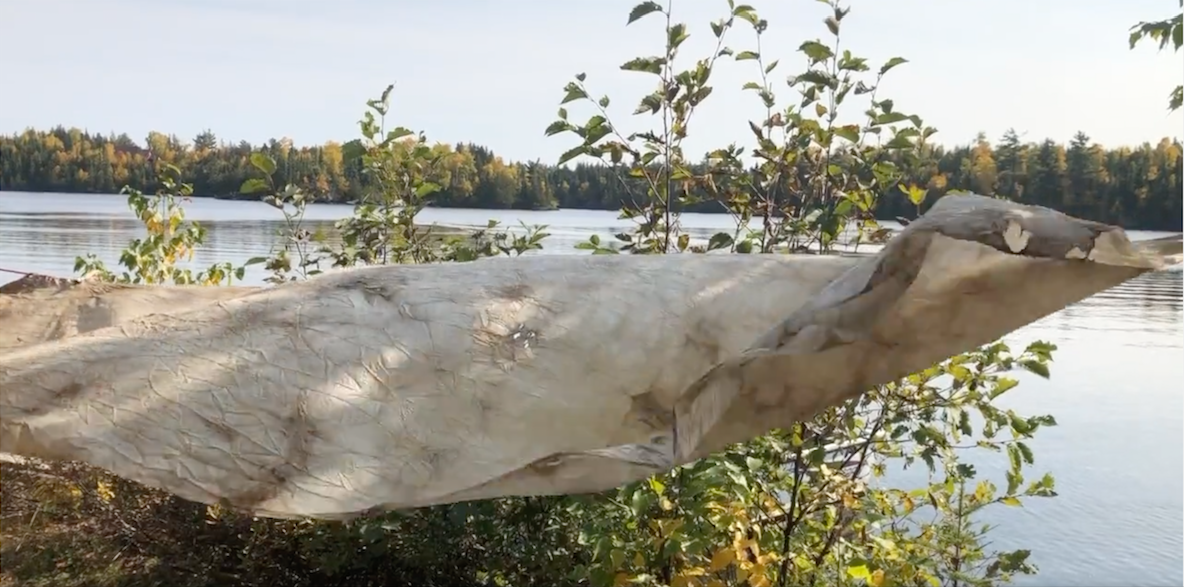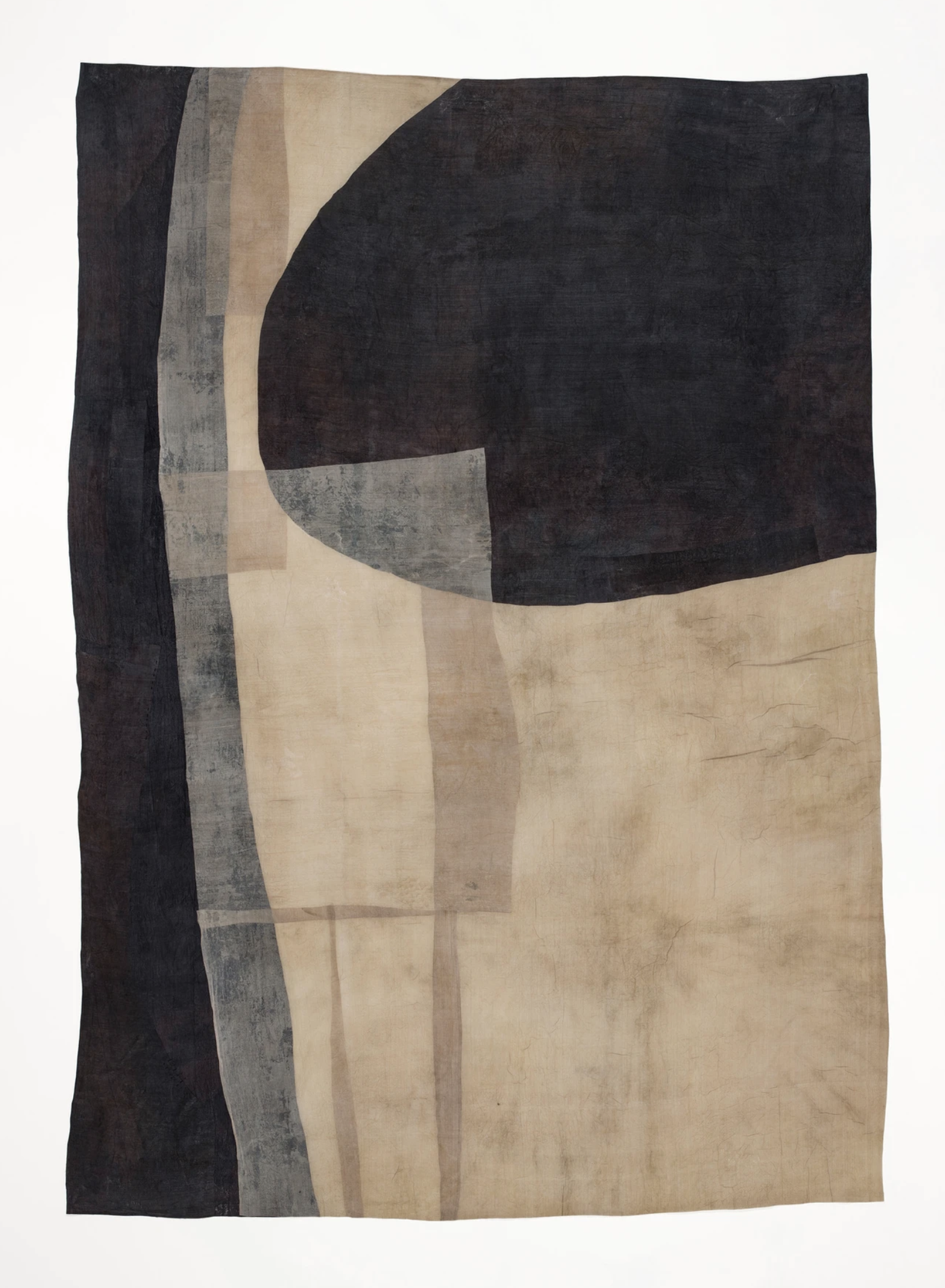
The Hungry Girls #7, linen, Fleece, thread, horse yoke, 112 x 24 inches.
Canvases that Flow through the Landscape like Rivers at Peace with the Earth: Moira Bateman’s Truly Sustainable Dye and Abstraction Practice
Olivia Ann Carye Hallstein
Moira Bateman makes work that extends local waterways onto canvas the way rivers expand lakes through the land. Using sediment and waters natural movement as her canvas, she works in conversation with the land by assembling her naturally dyed cloths into works of abstraction. Being in conversation with Moira, it quickly becomes obvious the consciousness of her work in relation to a deep reverence and appreciation of her surroundings. From sourcing to practice, to her expanded knowledge of local traditions and insights, and beyond to her personal compositional philosophy, Moira is an incredible example of a truly sustainable environmental artist.

Cloth after submerged in Prune Lake one year drying at lake edge, Gunflint Trail, Grand Marais, Minnesota.
Hello Moira, it is wonderful to get to know a practitioner who is as rooted in their surroundings as you are. Waterways are so relevant to the sustainability of landscapes and land politics. So, how about we start with you and move into larger topics from there… How about: what is your personal connection to water, its microbiology, and the Minnesota ecosystem? How has it nurtured you and how have you nurtured it through this work?
Minnesota is a very wet state! There’s up to 90,000 miles of shoreline around the lakes, wetlands, peatlands, rivers, and streams. Because water flows significantly out of and not into the state, it has been called “The center of the water universe of North America” …. most certainly by a Minnesotan. My favorite wayside rest is a three-way continental divide called The Giants Range, where water runs north to Hudson Bay, east to Lake Superior and the Atlantic Ocean, and south down the Mississippi River to the Gulf of Mexico. City water in Minneapolis comes from the Mississippi River. Like other Minnesotans, I have been nurtured by our waterways - spending so much time in boats, in lakes, on the edges of lakes and rivers, walking in bogs, and crossing rivers and streams on bridges as I move around my daily life…. Living here, it seems hard not to think about and be thankful for the water and its varied landscapes. In addition to ourselves, the diverse ecosystems, biodiversity of plants, and animals that live here depend on water. I hope to tell part of the story of this beautiful “Land Where the Waters Reflect the Clouds”.

Exhibition photo of By Way of Water (84 x 60 inches) and Watershed (72 x 144 inches), Bowery Gallery, New York City.
I am especially excited to dig into your work with water sediment as a dyeing medium. Firstly, how have the waterways influenced your process? And what have they taught you about their surroundings and history?
When I submerge cloth in a waterway, it is usually the bigger rivers where the cloth quickly becomes a darker shade of brown and begins disintegrating after a few weeks. I assume this is mostly from urban and agricultural run-off, but it may also be from the moving water on the cloth. I find the disintegration and unraveling of the fabric poignant as it represents a juxtaposition of fragility alongside strength; a theme that runs deep in my work.
I learned some remarkable things about changes in waterway sediments from paleolimnologists during a residency at the St. Croix Watershed Research Station in 2018. I joined scientists in their research boat as we pulled long tubes of lake bottom sediment from far below the lake surface. Studying the sediment layers helps measure change in historical diatom communities, lake productivity, and nutrient levels in relation to climate and land use. I used diatom-fossil rich lake bottom sediment in dying the cloth for my 2019 exhibition “By Way of Water” at The Bowery Gallery in New York City. The abstractions for this series were inspired by the microscopic images of diatoms and other microscopic lake life.

Retrieving cloth after submerged in Prune Lake one year, Gunflint Trail, Grand Marais, Minnesota.
You use bundling techniques to create textures in your abstract work. Are there any resist techniques that have worked best for your process?
I love shibori, but my experiments have been too distinct of patterns for my work. Strong patterns distract the eye from the overall abstractions I make and so I try to create more subtle changes by loosely bunching my fabrics when I dye them. This way, instead of patterns dyed in the fabric, I create the abstractions or patterning in my work by cutting holes or assembling light and dark pieces of fabric next to each other.
Your process of uncontrolled dye process combined with cutting and assembly makes your work uniquely conscious while still so abstract. What is the philosophy behind your compositional style and how does it relate to the ecosystems you are working with?
I work in abstractions because they keep my mind and eyes busy. Abstract work is my way of telling a story about ecosystems, the earth, and life. I use natural materials and processes as these add meaning to the story of the individual places. The places themselves collaborate and become imbued into the cloth and a part of the artwork. Abstraction suits this work best because the pieces are becoming a part of the place and telling their own story through the work. The work needs to be abstract because it is not portraying the place like a representational portrait--the places are bigger and more complex than a representational image could encompass.
Natural tannins, plant materials, iron-rich soils, and water can be unpredictable, but viscerally connected to life and the earth. As I discover how they interact, the work feels like a sort of alchemy. I go to remote places to source dye materials or leave my fabric submerged in a bog or lake bottom. I like getting my hands in the mud, literally. The cloth becomes imbued with the landscape, becoming a part of that place.
Last summer I attended a class with Aboubakar Fofana, a Malian bogolanfini (fermented mud-dye) master. I wanted to better understand the technical aspects around these traditional materials and processes. In addition to the technical fermented mud dye techniques, I loved learning Aboubakar Fofana’s methods of respectful collection of materials, conservation of water during the rinsing process, and the saving and re-use of every speck of dried mud. I am incorporating his thoughtful practices into my own processes.

Cloth after submerged in Lake of the Little Tree Spirits, Gneiss Outcrops, Minnesota.
What an incredible experience and inspiration Fofana must have been! Just like the Malian bogolanfini masters, your own work is deeply connected to the earth, ecosystem, and intention of place. How important is your Minnesota location to your work? Are there other makers who inspire you?
During graduate school I studied landscape architecture with dual concentrations in studio art and landscape ecology, the ecosystems of Minnesota being the primary focus. My aspirations looked towards earth artists like Robert Smithson and Nancy Holt as well as sculptors Eva Hesse, Magdalena Abakanowicz, and Eduardo Chillida. I was always drawn to cloth and textile art, but it wasn’t until about 2011 that I began using cloth in my work. The biggest influence for my work at that time came from author Patricia Eakins and her story “The Hungry Girls”. The work I made in response to her story made a monumental change in my art as it moved from the landscape into the gallery, and I started working with gestural markings on cloth to depict conceptual ideas.
Currently, I look to artists who attempt to tell the story of the environment and to effect positive change. I have always enjoyed the work of Maya Lin, but I especially admire her Memorial to Vanishing Nature Project: What is Missing. I also follow the work of Studio Olafur Eliasson and admire the variety of projects that highlight global warming but also seek to find solutions for clean sustainable energy.

By Way of Water, Peace Silk, Wax, Thread, Lake Bottom Sediment Stains, Iron, 84 x 60 inches.
You are not alone in your appreciation of local waterways. I understand that Minnesota is home to several indigenous communities like the Dakota and the Ojibwe, whose traditions are deeply connected to the regional waterways and lakes. Have the traditions of these tribes influenced your own understanding of these spaces?
The name Minnesota comes from the Dakota phrase Mni Sota Makoce which means “Land Where the Waters Reflect the Clouds”. Minnesota is the traditional homeland of the Dakota and their rich history here is many thousands of years old. An important book on Dakota history and culture in Minnesota is Mni Sota Makoce: The Land of the Dakota by Gwen Westerman and Bruce White. The many waterways of Minnesota hold special significance to the Dakota, including a creation story centering on Bdote (the confluence of the Minnesota and Mississippi Rivers), a location now surrounded by an international airport, an army fort, and many busy roadways and bridges. The Ojibwe people in Minnesota reached their current homeland by following the food that grows on the water (manoomin, or wild rice). This reminds me of the beautiful sight of vast stands of tall wild rice along stretches of the Mississippi River in northern Minnesota. Significantly, Indigenous Water Protectors in Minnesota have led the way in protecting waterways by working to stop the Enbridge Line 3 oil pipeline from crossing critical wetlands, lakes and the Mississippi River. There are innumerable lessons to learn about land and water stewardship from Indigenous neighbors.
As someone who values the world’s ecosystems, your work consciously uses only natural materials (silk, sediment, and wax). What do you pay attention to when sourcing your materials?
I use natural materials because they are the most interesting and alive to me. I practice conscientious and respectful collecting as well as conservation methods during my processes. I use peace silk which is fairly traded, sustainably sourced and cruelty free. The moths are not killed when they emerge from their cocoons. The people who weave the cloth earn a living wage and are involved in the business of selling their silk. I often think of the people who weave and the moths who make the beautiful silk that I use to create my work.
Lastly, what ecosystems are you working with currently? What would you like appreciators of your work to know?
My hope is to tell a story of these natural waterways that ultimately will help protect them. My current work, Etudes: Waterways, Bogs, Kayaks, is largely relating to the peat bogs of Northern Minnesota. I was eleven years old when I first stood on a quaking bog and since then I have been in awe of these beautiful, biodiverse landscapes teeming with life. I would love for people to know and love peatlands. In addition to being amazing biodiverse ecosystems and homes to many plants and animals, they are a climate super-hero. Peatlands store 30 per cent of the earth’s soil carbon while only covering 3 per cent of the earth’s surface. In Minnesota, about 10 per cent of the state is covered with peatland.
Thank you, Moira. It has truly been an honor and deeply inspiring to interview you.